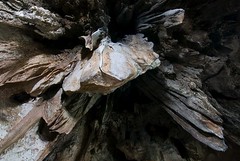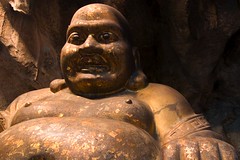
Buddha in a Cave
We visited one of the many caves in this limestone region of Kanchanaburi. The karst limestone forms teeth-like hills above ground, while below are found tunnels and chambers that prompts the idea that this is what it must be like to travel inside bowels and spines. Some of the caves are used as temples, others have more harrowing histories as Japanese World War 2 POW camps.
We visited Wat Khao Poon, a temple to Buddha and Ganesha and once a Japanese field hospital. After clambering down a flight of steep steps we came into a large, brightly-lit and roomy chamber with statues of the reclining Buddha and the rotund Chinese smiling Buddha. Beyond this is where the fun begins. Snaking and ducking along a series of narrow passages, brings us to one chamber after another. Each passage creeps further and further down into the ground, through broken and weathered limestone that looms into view as angular and bulbous formations akin to bones and bodily organs. Thankfully, very few of the walls ooze dampness.

Mighty Ceiling Stalactites
Large fossilised waterfalls spring into each passage and chamber in the form of massive stalactites and stalagmites that cascade from roof to floor in absolute stillness. Some stalactites are ridged into furrows and fins, while others look like petrified ripples on a beach. Some form columns while others flow over the limestone corners and curves. In places, the stillness is broken by a gentle drip of water, showing that the processes of stalactite formation are still busy. Everything else is motionless - apart from us. The pale blue grey whiteness of the limestone is devoid of any colour energy; the warm fetid air is immobile while no sound echoes come back from footfall. But we keep descending; down, down, down between the rock.

Ganesha
This lack of movement, in many ways, makes Wat Khao Poon a perfect place for meditation. Perhaps it is this, and a veneration of natural elements, that brought people to worship down here centuries ago. Each chamber is a temple or shrine. As we clamber through each opening we find statues of the Buddha, Brahma, Shiva and Ganesha set against the background of bent limestone and ribbed stalactites. Some images are dark, others golden, but most are draped in bright orange cloths. They are accompanied by dying flowers and burnt incense, while surfaces are covered in small squares of gold leaf. Each is a testament to an unseen act of worship.

Laughing Buddha
Eventually we begin to climb, the turn in direction coming after the largest chamber with the largest Buddha statue. The air begins to turn a little fresher and at last the white fluorescence of the artificial lights give way to a warmer hue. We look up to see an opening, beyond which the green leaves and branches of a tree striate the blue sky. We return above ground, leaving the underworld once more in peace.



No comments:
Post a Comment